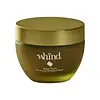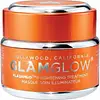Whind Atlas Pure Versus GLAMGLOW FLASHMUD™
What's inside
What's inside
 Key Ingredients
Key Ingredients

 Benefits
Benefits

 Concerns
Concerns

 Ingredients Side-by-side
Ingredients Side-by-side

Water
Skin ConditioningGlycerin
HumectantStearic Acid
CleansingButylene Glycol
HumectantIllite
AbrasiveGlyceryl Stearate
EmollientTriethanolamine
BufferingPEG-8
HumectantCI 77891
Cosmetic ColorantCaramel
Cosmetic ColorantHydroxyacetophenone
AntioxidantKaolin
AbrasiveCaprylic/Capric Triglyceride
MaskingMentha Piperita Leaf Water
Skin ConditioningEthylhexylglycerin
Skin ConditioningAllantoin
Skin ConditioningPotassium Sorbate
PreservativeBisabolol
MaskingSorbitan Caprylate
EmulsifyingTetrasodium EDTA
Salicylic Acid
MaskingMentha Piperita Oil
MaskingVerbena Officinalis Flower/Leaf Extract
MaskingTocopherol
AntioxidantCI 19140
Cosmetic ColorantPanthenol
Skin ConditioningBenzyl Alcohol
PerfumingLimonene
PerfumingAscorbyl Palmitate
AntioxidantPhenoxyethanol
PreservativeEscin
TonicVitis Vinifera Fruit Extract
Skin ConditioningRuscus Aculeatus Root Extract
AstringentAmmonium Glycyrrhizate
MaskingAscorbic Acid
AntioxidantCitric Acid
BufferingDehydroacetic Acid
PreservativeCentella Asiatica Extract
CleansingWater, Glycerin, Stearic Acid, Butylene Glycol, Illite, Glyceryl Stearate, Triethanolamine, PEG-8, CI 77891, Caramel, Hydroxyacetophenone, Kaolin, Caprylic/Capric Triglyceride, Mentha Piperita Leaf Water, Ethylhexylglycerin, Allantoin, Potassium Sorbate, Bisabolol, Sorbitan Caprylate, Tetrasodium EDTA, Salicylic Acid, Mentha Piperita Oil, Verbena Officinalis Flower/Leaf Extract, Tocopherol, CI 19140, Panthenol, Benzyl Alcohol, Limonene, Ascorbyl Palmitate, Phenoxyethanol, Escin, Vitis Vinifera Fruit Extract, Ruscus Aculeatus Root Extract, Ammonium Glycyrrhizate, Ascorbic Acid, Citric Acid, Dehydroacetic Acid, Centella Asiatica Extract
Water
Skin ConditioningSilica
AbrasiveKaolin
AbrasiveCetyl Alcohol
EmollientC12-15 Alkyl Benzoate
AntimicrobialButylene Glycol
HumectantNiacinamide
SmoothingAcetyl Glucosamine
Skin ConditioningPolymethylsilsesquioxane
Pumice
AbrasiveGlyceryl Stearate
EmollientPEG-100 Stearate
Pentylene Glycol
Skin ConditioningDiamond Powder
AbrasiveRosmarinus Officinalis Leaf Extract
AntimicrobialBetula Alba Leaf Extract
AstringentLactic Acid
BufferingPaeonia Suffruticosa Root Extract
Skin ProtectingTetrahexyldecyl Ascorbate
AntioxidantBetula Pendula Wood Powder
Skin ConditioningSalicylic Acid
MaskingLilium Candidum Bulb Extract
Skin ConditioningGlycerin
HumectantRibes Nigrum Seed Oil
EmollientSolidago Virgaurea Extract
Skin ConditioningOctyldodecyl Oleate
EmollientEthylhexylglycerin
Skin ConditioningRosa Canina Flower Extract
AstringentOctyldodecanol
EmollientCamellia Sinensis Leaf Extract
AntimicrobialAllantoin
Skin ConditioningJasminum Officinale Flower Extract
MaskingTocopheryl Acetate
AntioxidantOctyldodecyl Stearoyl Stearate
EmollientMagnesium Aluminum Silicate
AbsorbentXanthan Gum
EmulsifyingParfum
MaskingBenzyl Alcohol
PerfumingAlpha-Isomethyl Ionone
PerfumingBenzyl Benzoate
AntimicrobialLinalool
PerfumingAmyl Cinnamal
PerfumingHexyl Cinnamal
PerfumingBenzyl Salicylate
PerfumingLimonene
PerfumingGeraniol
PerfumingDisodium EDTA
Potassium Sorbate
PreservativePhenoxyethanol
PreservativeCI 77891
Cosmetic ColorantWater, Silica, Kaolin, Cetyl Alcohol, C12-15 Alkyl Benzoate, Butylene Glycol, Niacinamide, Acetyl Glucosamine, Polymethylsilsesquioxane, Pumice, Glyceryl Stearate, PEG-100 Stearate, Pentylene Glycol, Diamond Powder, Rosmarinus Officinalis Leaf Extract, Betula Alba Leaf Extract, Lactic Acid, Paeonia Suffruticosa Root Extract, Tetrahexyldecyl Ascorbate, Betula Pendula Wood Powder, Salicylic Acid, Lilium Candidum Bulb Extract, Glycerin, Ribes Nigrum Seed Oil, Solidago Virgaurea Extract, Octyldodecyl Oleate, Ethylhexylglycerin, Rosa Canina Flower Extract, Octyldodecanol, Camellia Sinensis Leaf Extract, Allantoin, Jasminum Officinale Flower Extract, Tocopheryl Acetate, Octyldodecyl Stearoyl Stearate, Magnesium Aluminum Silicate, Xanthan Gum, Parfum, Benzyl Alcohol, Alpha-Isomethyl Ionone, Benzyl Benzoate, Linalool, Amyl Cinnamal, Hexyl Cinnamal, Benzyl Salicylate, Limonene, Geraniol, Disodium EDTA, Potassium Sorbate, Phenoxyethanol, CI 77891
Ingredients Explained
These ingredients are found in both products.
Ingredients higher up in an ingredient list are typically present in a larger amount.
Allantoin is a soothing ingredient known for its protective and moisturizingg properties. Because of this, it is often added to products with strong active ingredients.
Studies show higher concentrations of this ingredient can promote wound healing.
Though it can be derived from the comfrey plant, allantoin is produced synthetically for cosmetic products to ensure purity.
Learn more about AllantoinBenzyl Alcohol is most commonly used as a preservative. It also has a subtle, sweet smell. Small amounts of Benzyl Alcohol is not irritating and safe to use in skincare products. Most Benzyl Alcohol is derived from fruits such as apricots.
Benzyl Alcohol has both antibacterial and antioxidant properties. These properties help lengthen the shelf life of products. Benzyl Alcohol is a solvent and helps dissolve other ingredients. It can also improve the texture and spreadability.
Alcohol comes in many different forms. Different types of alcohol will have different effects on skin. This ingredient is an astringent alcohol.
Using high concentrations of these alcohols are drying on the skin. They may strip away your skin's natural oils and even damage your skin barrier. Astringent alcohols may also irritate skin.
Other types of astringent alcohols include:
According to the National Rosacea Society based in the US, you should be mindful of products with these alcohols in the top half of ingredients.
Any type of sanitizing product will have high amounts of alcohol to help kill bacteria and viruses.
Learn more about Benzyl AlcoholButylene Glycol (or BG) is used within cosmetic products for a few different reasons:
Overall, Butylene Glycol is a safe and well-rounded ingredient that works well with other ingredients.
Though this ingredient works well with most skin types, some people with sensitive skin may experience a reaction such as allergic rashes, closed comedones, or itchiness.
Learn more about Butylene GlycolCi 77891 is a white pigment from Titanium dioxide. It is naturally found in minerals such as rutile and ilmenite.
It's main function is to add a white color to cosmetics. It can also be mixed with other colors to create different shades.
Ci 77891 is commonly found in sunscreens due to its ability to block UV rays.
Learn more about CI 77891Ethylhexylglycerin (we can't pronounce this either) is commonly used as a preservative and skin softener. It is derived from glyceryl.
You might see Ethylhexylglycerin often paired with other preservatives such as phenoxyethanol. Ethylhexylglycerin has been found to increase the effectiveness of these other preservatives.
Glycerin is already naturally found in your skin. It helps moisturize and protect your skin.
A study from 2016 found glycerin to be more effective as a humectant than AHAs and hyaluronic acid.
As a humectant, it helps the skin stay hydrated by pulling moisture to your skin. The low molecular weight of glycerin allows it to pull moisture into the deeper layers of your skin.
Hydrated skin improves your skin barrier; Your skin barrier helps protect against irritants and bacteria.
Glycerin has also been found to have antimicrobial and antiviral properties. Due to these properties, glycerin is often used in wound and burn treatments.
In cosmetics, glycerin is usually derived from plants such as soybean or palm. However, it can also be sourced from animals, such as tallow or animal fat.
This ingredient is organic, colorless, odorless, and non-toxic.
Glycerin is the name for this ingredient in American English. British English uses Glycerol/Glycerine.
Learn more about GlycerinGlyceryl Stearate is a mix of glycerin and stearic acid.
It is used to stabilize the mixing of water and oil ingredients. By preventing these ingredients from separating, it can help elongate shelf life. It can also help thicken the product's texture.
As an emollient, it helps soften skin and supports barrier-replenishing ingredients.
In cosmetics, Glyceryl Stearate is often made from vegetable oils or synthetically produced.
This ingredient may not be fungal-acne safe
Fun fact: The human body also creates Glyceryl Stearate naturally.
Learn more about Glyceryl StearateKaolin is a clay. It is used for oil control and to help minimize pores. Like other clays, kaolin has the ability to absorb excess sebum or oil. This can help clean out pores and mattify the skin.
Some types of kaolin may have exfoliating properties. When water is added to kaolin, it becomes a paste with small abrasive particles.
Most kaolin is a white color, but may be pink/orange/red depending on where it comes from.
The name 'kaolin' comes from a Chinese village named 'Gaoling'. Kaolin clay comes from rocks rich in kaolinite. Kaolinite, the mineral, has a silicate layered structure. Kaolinite is formed from chemical weathering of aluminum siilicate minerals.
Besides skincare, kaolin is commonly used to make glossy paper, in ceramics, toothpaste, and as medicine to soothe stomach issues.
Learn more about KaolinLimonene is a fragrance that adds scent and taste to a formulation.
It's found in the peel oil of citrus fruits and other plants such as lavender and eucalyptus. The scent of limonene is generally described as "sweet citrus".
Limonene acts as an antioxidant, meaning it helps neutralize free radicals.
When exposed to air, oxidized limonene may sensitize the skin. Because of this, limonene is often avoided by people with sensitive skin.
The term 'fragrance' is not regulated in many countries. In many cases, it is up to the brand to define this term. For instance, many brands choose to label themselves as "fragrance-free" because they are not using synthetic fragrances. However, their products may still contain ingredients such as essential oils that are considered a fragrance.
Learn more about LimonenePhenoxyethanol is a preservative that has germicide, antimicrobial, and aromatic properties. Studies show that phenoxyethanol can prevent microbial growth. By itself, it has a scent that is similar to that of a rose.
It's often used in formulations along with Caprylyl Glycol to preserve the shelf life of products.
Potassium Sorbate is a preservative used to prevent yeast and mold in products. It is commonly found in both cosmetic and food products.
This ingredient comes from potassium salt derived from sorbic acid. Sorbic acid is a natural antibiotic and effective against fungus.
Both potassium sorbate and sorbic acid can be found in baked goods, cheeses, dried meats, dried fruit, ice cream, pickles, wine, yogurt, and more.
You'll often find this ingredient used with other preservatives.
Learn more about Potassium SorbateSalicylic Acid (also known as beta hydroxy acid or BHA) is a well-known ingredient for treating skin that struggles with acne and clogged pores. It exfoliates both the skin's surface and deep within the pores to help clear out buildup, control oil, and reduce inflammation.
Unlike AHAs (alpha hydroxy acids), salicylic acid is oil-soluble. This allows it to penetrate into pores which makes it especially effective for treating blackheads and preventing future breakouts.
Salicylic acid is also known for its soothing properties. It has a similar structure to aspirin and can calm inflamed or irritated skin, making it a good option for acne-prone skin that is also sensitive.
Concentrations of 0.5-2% are recognized by the U.S. FDA as an over-the-counter topical acne product.
It can cause irritation and/or dryness if one's skin already has a compromised moisture barrier, so it's best to focus on repairing that before introducing this ingredient into your routine.
While salicylic acid does not increase sun sensitivity, it’s still important to wear sunscreen daily to protect your skin.
If you are looking for the ingredient called BHA or Butylated Hydroxyanisole, click here.
Learn more about Salicylic AcidWater. It's the most common cosmetic ingredient of all. You'll usually see it at the top of ingredient lists, meaning that it makes up the largest part of the product.
So why is it so popular? Water most often acts as a solvent - this means that it helps dissolve other ingredients into the formulation.
You'll also recognize water as that liquid we all need to stay alive. If you see this, drink a glass of water. Stay hydrated!
Learn more about Water